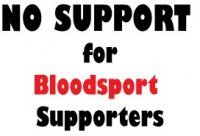Daily Writing Campaign to help pass H.R. 503 American Horse Slaughter Prevention ActShare. Yesterday at 3:44am
Wild Horses...idea thank you
Please join our daily writing campaign to help pass H.R. 503 American Horse Slaughter Prevention Act.
We are asking that everyone help in to keeping the momentum going after the victory in Missouri
This is a group collaboration writing campaign to help pass H.R. 503 American Horse Slaughter Prevention Act.
Please post and share to all your friends and those concerned in ending horse slaughtering for ever.
PROJECT: H.R. 503. Every day we shall post only 1 member from the subcommittee who will be involved in HR503. Please write/fax and /or email and ask the subcommittee member for that day to please pass H.R.503 to Ban Horse Slaughter in America.
American Horse Slaughter Prevention Act, H.R. 503
H.R.503: To amend the Horse Protection Act to prohibit the shipping, transporting, moving, delivering, receiving, possessing, purchasing, selling, or donation of horses and other equines to be slaughtered for human consumption, and for other purposes.
http://animallawcoalition.com/horse-slaughter/article/567
First subcommittee member for Monday May 17, 2010 (16 total)
http://judiciary.house.gov/about/subcrime.html
#1 Hon. Bobby Scott, Chairman
1201 Longworth House Office Building
Washington, DC 20515
(202) 225-8351 | FAX (202) 225-8354 See More
(D) Virginia, 3rd
Enter Virginia, then zip code: 23219
https://writerep.house.gov/writerep/welcome.shtml
________________________________________________________________________
ALL 16 Subcommittee Members:
House Subcommittee on Crime, Terrorism, and Homeland Security
MY HR 503 SUBCOMMITTEE CONTACT SHEET May 17th 2010
vertical listing
ALL 16 Subcommittee Members:
House Subcommittee on Crime, Terrorism, and Homeland Security
#1
The Honorable Bobby Scott ( D - VA 3rd District )
United States House of Representatives
1201 Longworth House Office Building
Washington, D.C. 20515-4603
DC Phone: 202-225-8351 DC Fax: 202-225-8354
no email, if you find one please let me know.
Enter Virginia, then zip code: 23219
1. https://writerep.house.gov/writerep/welcome.shtml
http://bobbyscott.house.gov/index.php?option=com_content&view=article&id=272&Itemid=60
District Offices:
400 North 8th Street, Suite 430
Richmond, VA 23219-4805
Voice: 804-644-4845 FAX: 804-648-6026
or
600 Washington Avenue, Suite 1010
Newport News, VA 23607-4317
Voice: 757-380-1000 FAX: 757-928-6694
2#
The Honorable Pedro Pierluisi (D - PR )
United States House of Representatives
1218 Longworth House Office Building
Washington, D.C. 20515-5401
DC Phone: 202-225-2615 DC Fax: 202-225-2154
http://pierluisi.house.gov/english/contact-us.html
http://pierluisi.house.gov/english/home.html
#3
The Honorable Jerrold Nadler ( D - NY 8th District )
United States House of Representatives
2334 Rayburn House Office Building
Washington, D.C. 20515-3208
DC Phone: 202-225-5635 DC Fax: 202-225-6923
Email Address:
http://jerroldnadler.house.gov/Forms/WriteYourRep/
http://nadler.house.gov/
#4
The Honorable Zoe Lofgren ( D -CA 16th District )
United States House of Representatives
102 Cannon House Office Building
Washington, D.C. 20515-0516
DC Phone: 202-225-3072 DC Fax: 202-225-3336
http://forms.house.gov/lofgren/webforms/contactzipauth.html
http://www.lofgren.house.gov/
#5
The Honorable Sheila Jackson Lee ( D -TX - 18th District )
United States House of Representatives
2160 Rayburn House Office Building
Washington, D.C. 20515-4318
DC Phone: 202-225-3816 DC Fax: 202-225-3317
http://www.jacksonlee.house.gov/Contact/
http://www.jacksonlee.house.gov/
#6
The Honorable Maxine Waters ( D - CA 35th District )
United States House of Representatives
2344 Rayburn House Office Building
Washington, D.C. 20515-0535
DC Phone: 202-225-2201 DC Fax: 202-225-7854
Email Address:
https://waters.house.gov/Contact/ContactForm.htm
http://waters.house.gov/
#7
The Honorable Steve Cohen ( D - TN 9th District )
United States House of Representatives
1005 Longworth House Office Building
Washington, D.C. 20515-4209
DC Phone: 202-225-3265 DC Fax: 202-225-5663
http://cohen.house.gov/index.php?option=com_email_form&Itemid=111
http://cohen.house.gov/
#8
The Honorable Anthony Weiner ( D - NY 9th District )
United States House of Representatives
2104 Rayburn House Office Building
Washington, D.C. 20515-3209
DC Phone: 202-225-6616 DC Fax: 202-226-0218
http://weiner.house.gov/email_anthony.aspx
http://weiner.house.gov/
9#
The Honorable Mike Quigley ( D -Il 5th District )
United States House of Representatives
1319 Longworth House Office Building
Washington, D.C. 20515-1305
DC Phone: 202-225-4061 DC Fax: 202-225-5603
https://forms.house.gov/quigley/contact-form.shtml
http://quigley.house.gov/
#10
The Honorable Ted Deutch ( D - Fl 19th District )
United States House of Representatives
2241 Rayburn HOB
Washington, D.C. 20515
DC Phone: (202) 225-3001 DC Fax: (202) 225-5974
https://teddeutch.house.gov/Forms/WriteYourRep/default.aspx
http://deutch.house.gov/contact/write-or-phone-my-offices.shtml/
http://deutch.house.gov/
Margate Office
Representative Ted Deutch
5790 Margate Blvd
Margate, FL 33063
Phone: (954) 972-6454 Fax: (954) 974-3191
#11
The Honorable Louie Gohmert ( R - TX 1rst District )
United States House of Representatives
511 Cannon House Office BuildingWashington, D.C. 20515-4301
DC Phone: 202-225-3035 DC Fax: 202-226-1230
http://gohmert.house.gov/index.cfm?sectionid=36&itemid=13
http://gohmert.house.gov/index.html
#12
The Honorable Ted Poe ( R -TX 2nd District )
United States House of Representatives
430 Cannon House Office Building
Washington, D.C. 20515-4302
DC Phone: 202-225-6565 DC Fax: 202-225-5547
http://poe.house.gov/contact/contactform.htm
http://poe.house.gov/
#13
The Honorable Bob Goodlatte ( R-VA 6th district )
United States House of Representatives
2240 Rayburn House Office Building
Washington, D.C. 20515-4606
DC Phone: 202-225-5431 DC Fax: 202-225-9681
http://goodlatte.house.gov/contact/index.shtml
http://goodlatte.house.gov/
#14
The Honorable Dan Lungren ( R-CA 3rd District )United States House of Representatives
2262 Rayburn House Office Building
Washington, D.C. 20515-0503
DC Phone: 202-225-5716 DC Fax: 202-226-1298
http://lungren.house.gov/index.php?option=com_content&task=view&id=146&
http://lungren.house.gov/
#15
The Honorable J. Randy Forbes ( R-VA 4th District )
United States House of Representatives
2438 Rayburn House Office Building
Washington, D.C. 20515-4604
DC Phone: 202-225-6365 DC Fax: 202-226-1170
http://randyforbes.house.gov/Contact/ZipAuth.htm
http://randyforbes.house.gov/
#16
The Honorable Thomas J. Rooney ( R- Fl 6th District )
United States House of Representatives
1529 Longworth House Office Building
Washington, D.C. 20515-0916
DC Phone: 202-225-5792 DC Fax: 202-225-3132
http://rooney.house.gov/index.cfm?sectionid=7§iontree=47
http://randyforbes.house.gov/
PLEASE REMEMBER TO CONTACT YOUR LOCAL REPRESENTATIVE AND URGE THEM TO PASS H.R 5O3
https://writerep.house.gov/writerep/welcome.shtml
Please read:
http://www.defendhorsescanada.org/ChambersofCarnage.html
http://www.journeysendranchanimalsanctuary.org/slaughter-of-horses-facts.html
http://www.manesandtailsorganization.org/captive_bolt.htm
Please Sign Petition:
http://www.change.org/petitions/view/prevention_of_equine_cruelty_act_hr_503s_727?js_fb

















